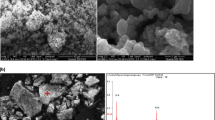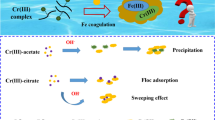Abstract
Chromium (Cr(VI)) is a very toxic and carcinogenic element, which is widely present in groundwaters, mainly due to geogenic conditions. The limit of Cr(VI) in drinking water is expected to be reduced to 10 μg/L in both the USA and the European Union. Recent literature findings indicated that the most efficient process in reducing Cr(VI) levels to below 10 μg/L proved to be Cr(VI) reduction by Fe(II), by applying a molar ratio Fe(II)/Cr(VI) of around 9. In the present work, we investigated the reduction of Cr(VI) by Fe(II) in pipe flocculation reactors followed by filtration of insoluble products by microfiltration. The proposed technology involves re-circulation of a part of the sludge in the pipe reactors, in order to improve kinetics and efficiency of the process. The obtained results showed that with a Fe(II) dose of around 1 mg/L, Cr(VI) was reduced to below 10 μg/L, by even an initial concentration as high as 300 μg/L of Cr(VI), corresponding to a molar ratio Fe(II)/Cr(VI) of around 3, thus reducing the overall quantity of reductive reagents and of the produced sludge. This ratio was also confirmed by the XPS analysis, which also showed that Cr(VI) was reduced to Cr(III) and then precipitated either as Cr(OH)3 or associated with the produced iron oxides.






Similar content being viewed by others
References
Boursiquot S, Mullet M, Ehrhardt J-J (2002) XPS study of the reaction of chromium (VI) with mackinawite (FeS). Surf Interface Anal 34:293–297
Buerge IJ, Hug SJ (1997) Kinetics and pH dependence of chromium(VI) reduction by iron(II). Environ Sci Technol 31:1426–1432
Buerge I, Hug SJ (1999) Influence of mineral surfaces on chromium (VI) reduction by iron(II). Environ. Sci. Technol. 33:4285–4291
Clesceri LS, Greenberg AE, Trussell RR (1989) Standard methods for the examination of water and wastewater, 17th edn. American Public Health Association, Washington, DC
Costa M (2003) Potential hazards of hexavalent chromate in our drinking water. Toxicol Appl Pharmacol 188:1–5
Fantoni D, Brozzo G, Canepa M, Cipolli F, Marini L, Ottonello G, Vetuschi Zuccolini M (2002) Natural hexavalent chromium in groundwaters interacting with ophiolitic rocks. Environ Geol 42:871–882
Gröhlich A, Langer M, Mitrakas M, Zouboulis A, Katsoyiannis I, Ernst M (2017) Effect of organic matter on Cr (VI) removal from groundwaters by Fe (II) reductive precipitation for groundwater treatment. Water 9(6):389–404. doi:10.3390/w9060389
Kaprara E, Kazakis N, Simeonidis K, Coles S, Zouboulis AI, Samaras P, Mitrakas M (2015) Occurrence of Cr(VI) in drinking water of Greece and relation to the geological background. J Hazard Mater 281:2–11
Katsoyiannis IA, Zouboulis AI, Mitrakas M, Althoff HW, Bartel H (2013) A hybrid system incorporating a pipe reactor and microfiltration for biological iron, manganese and arsenic removal from anaerobic groundwater. Fresenius Environ Bull 22:3848–3853
Kazakis N, Kantiranis N, Voudouris KS, Mitrakas M, Kaprara E, Pavlou A (2015) Geogenic Cr oxidation on the surface of mafic minerals and the hydrogeological conditions influencing hexavalent chromium concentrations in groundwater. Sci Total Environ 514:224–238
Lee G, Hering JG (2003) Removal of chromium(VI) from drinking water by redox-assisted coagulation with iron(II). J Water Supply Res Technol-AQUA 52:319–332
Linos A, Petralias A, Christophi CA, Christoforidou E, Kouroutou P, Stoltidis M, Veloudaki A, Tzala E, Makris KC, Karagas MR (2011) Oral ingestion of hexavalent chromium through drinking water and cancer mortality in an industrial area of Greece—an ecological study. Environ Health 10:50
Manning B, Kiser JR, Kwon H, Kanel SR (2007) Spectroscopic investigation of Cr(III)- and Cr(VI)-treated nanoscale zero-valent iron. Environ. Sci. Technol. 41:586–592
Martin-Lara MA, Blazquez G, Trujillo MC, Perez A, Calero M (2014) New treatment of real electroplating wastewater containing heavy metals by adsorption onto olive stone. J Cleaner Production 81:120–129
Mitrakas MG, Pantazatou AS, Tzimou-Tsitouridou R, Sikalidis CA (2011) Influence of pH and temperature on Cr(VI) removal from a natural water using Fe(II): a pilot and full scale case study. Desalin Water Treat 33:77–85
Mohan D, Pittman CU (2006) Activated carbons and low cost adsorbents for remediation of tri- and hexavalent chromium from water. J Hazard Mater 137:762–811
Owlad M, Aroua MK, Daud WAW, Baroutian S (2009) Removal of hexavalent chromium from contaminated water and wastewaters: a review. Water Air Soil Pollut 200:59–77
Paparazzo E (1988) XPS analysis of oxides. Surf Interface Anal 12:115–118
Simeonidis K, Kaprara E, Samaras T, Angelakeris M, Pliatsikas N, Vourlias G, Mitrakas M, Andritsos N (2015) Optimizing magnetic nanoparticles for drinking water technology: the case of Cr(VI). Sci Total Environ 535:61–68
Stumm W, Lee GF (1961) Oxygenation of ferrous iron. Ind Eng Chem 53:143–146
US-EPA (2014) California regulations related to drinking water, 2014. 1 July 2014 (Revisions effective on 1 July 2014)
Zhao Y, Zhao D, Chen C, Wang X (2013) Enhanced photo-reduction and removal of Cr(VI) on reduced graphene oxide decorated with TiO2 nanoparticles. J Colloid Interf Sci 405:211–217
Zhou X, Lv B, Zhou Z, Li W, **g G (2015) Evaluation of highly active nanoscale zero-valent iron coupled with ultrasound for chromium(VI) removal. Chem Eng J 281:155–163
Zhu K, Gao Y, Tan X, Chen C (2016) Polyaniline-modified mg/al layered double hydroxide composites and their application in efficient removal of Cr(VI). ACS Sustain Chem Eng 4:4361–4369
Acknowledgments
This work has been supported by the bilateral program IKYDA 2016, with the acronym ACr-Tech.
Author information
Authors and Affiliations
Corresponding author
Additional information
Responsible editor: Bingcai Pan
Rights and permissions
About this article
Cite this article
Stylianou, S., Simeonidis, K., Mitrakas, M. et al. Reductive precipitation and removal of Cr(VI) from groundwaters by pipe flocculation-microfiltration. Environ Sci Pollut Res 25, 12256–12262 (2018). https://doi.org/10.1007/s11356-017-9967-4
Received:
Accepted:
Published:
Issue Date:
DOI: https://doi.org/10.1007/s11356-017-9967-4




